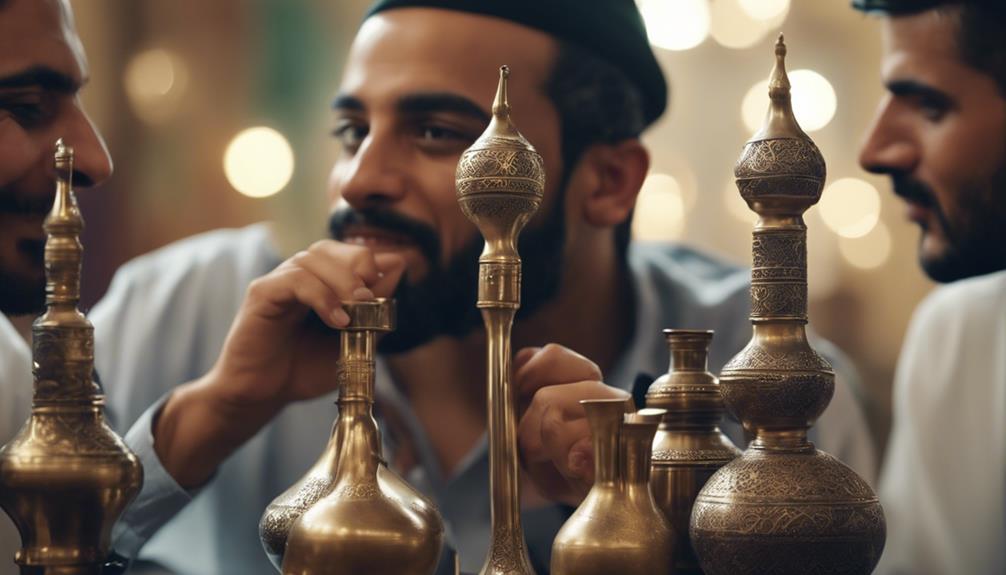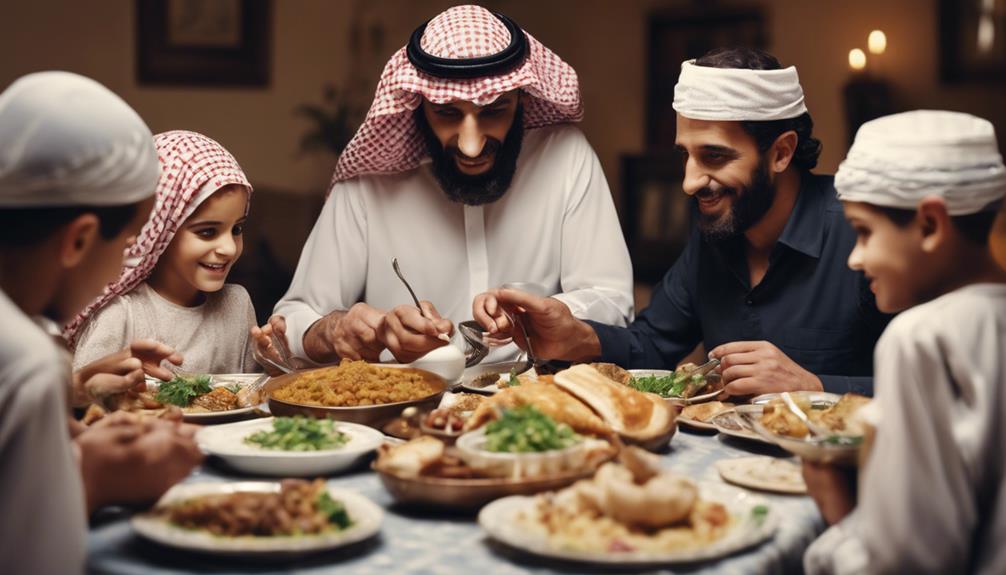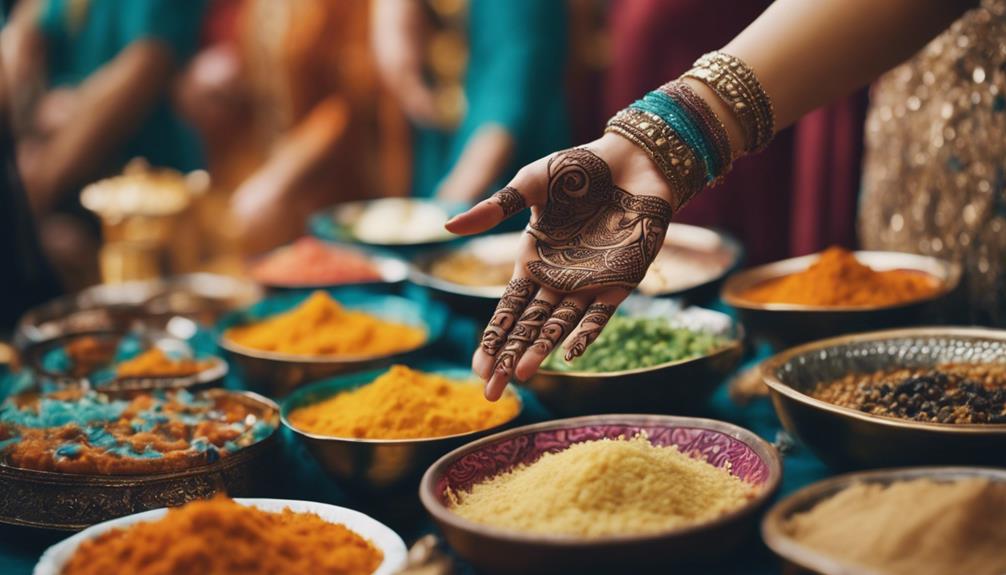Discover the fascinating tapestry of Arab culture through its language, cuisine, and traditions. Arabic, with its numerous dialects, offers a glimpse into unique cultural nuances.
From traditional lamb and rice dishes to modern culinary influences, Arab cuisine tantalizes taste buds globally. The region's festivals and celebrations showcase vibrant dances, music, and culinary delights.
Explore the customs and social norms emphasizing hospitality, respect, and community bonds. Arab arts, music, and architecture richly illustrate the cultural expressions and historical influences.
Explore the intricate layers of Arab culture, where each aspect weaves a story of tradition and heritage.
Key Takeaways
- Arabic language reflects diverse cultural nuances through various dialects.
- Arab cuisine emphasizes hospitality and togetherness with regional specialties.
- Festivals and traditions honor significant events, fostering unity and cultural richness.
- Arab customs prioritize hospitality, respect, and community bonds.
- Arab arts, music, and architecture showcase cultural expressions and historical influences.
Arab Language and Dialects

Arabic language, with its diverse range of dialects, plays an important role in shaping the cultural landscape of the Arab world. With 30 different dialects spoken across the region, communication varies depending on the country and context. Modern Standard Arabic (MSA) serves as the formal, standardized version used in writing and formal settings, ensuring a level of linguistic unity.
However, colloquial Arabic dialects, such as Egyptian Arabic, Levantine Arabic, and Gulf Arabic, differ greatly by region, reflecting unique cultural nuances and histories.
Arabic script further distinguishes itself by being written from right to left, utilizing 28 letters and additional diacritical marks for pronunciation. Understanding these dialects is essential for fostering cultural understanding and effective communication with native speakers.
Learning Arabic dialects not only aids in language acquisition but also opens doors to the rich tapestry of Arab culture, allowing for deeper connections and appreciation of the traditions that define this diverse and vibrant region.
Culinary Delights of Arab Cuisine
With a rich tapestry of diverse flavors and ingredients, Arab cuisine has captivated taste buds worldwide. Known for its use of ingredients like lamb, chicken, cumin, and coriander, Arab cuisine offers a unique and flavorful culinary experience. Popular dishes such as falafel, hummus, shawarma, baklava, and halva showcase the rich culinary tradition of the Arab world, appealing to a wide audience with their distinct tastes.
One of the remarkable aspects of Arab cuisine is the regional variations that offer unique specialties reflecting the cultural diversity across different Arab countries. These variations add depth and complexity to the culinary landscape, making each dish a culinary adventure. Arabic cuisine successfully blends traditional recipes with modern influences, creating a fusion that resonates with global palates.
Moreover, Arab cuisine emphasizes hospitality, with meals often serving as a way to connect, share, and celebrate with family and friends. This cultural aspect adds warmth and richness to the dining experience, making Arab cuisine not just a feast for the taste buds but also a celebration of togetherness.
Traditional Arab Festivals and Celebrations

During traditional Arab festivals and celebrations, a vibrant tapestry of cultural traditions and joyful gatherings come together to honor significant events and foster a sense of unity among communities. Notable celebrations such as Eid al-Fitr and Eid al-Adha hold special importance, marking the end of Ramadan and commemorating the willingness of Prophet Ibrahim to sacrifice his son. These festivals are characterized by traditional Arab dances like dabke and music performances, adding to the festive spirit. Culinary delights also play a central role, with dishes like biryani, baklava, and maamoul showcasing the cultural richness and culinary diversity of Arab traditions.
Moreover, decorative elements such as colorful lanterns, intricate henna designs, and traditional attire enhance the festive ambiance of Arab celebrations, creating a visually stunning experience. Alongside the festivities, community gatherings, charity events, and prayers are integral components, serving to foster unity and spiritual reflection among participants. Arab festivals serve as occasions that not only celebrate cultural heritage but also strengthen the bonds within communities.
Time-Honored Arab Customs
Exploring the fabric of Arab society reveals a tapestry woven with time-honored customs that underscore the values of hospitality, family, community, respect for elders, and adherence to etiquette.
Hospitality stands as a cornerstone of Arab culture, with guests warmly welcomed and treated with utmost respect. The importance of family is deeply ingrained in traditional Arab customs, with strong familial ties and a focus on supporting one another through thick and thin.
Community plays a crucial role in Arab society, with communal gatherings and events serving as key platforms for social interactions and cohesion.
Respect for elders is a revered custom in Arab culture, where the wisdom and experience of older generations are highly valued and respected. Etiquette holds significant importance, with norms such as using the right hand for eating, removing shoes when entering a home, and demonstrating politeness in speech and behavior. These time-honored customs not only shape daily interactions but also reflect the rich cultural heritage and values cherished by Arab communities.
Arab Music and Dance Traditions

Arab music and dance traditions showcase a vibrant tapestry of cultural expressions and storytelling through rhythmic melodies and intricate movements. Traditional Arabic music incorporates instruments like oud, qanun, and darbuka, creating rich and diverse soundscapes. These musical elements are often accompanied by poetic lyrics that convey deep emotions and narratives. In the domain of dance, belly dancing and dabke stand out as popular traditional Arabic styles that embody cultural pride and history through graceful movements and gestures.
Music and dance hold significant roles in Arab cultural celebrations, weddings, and social gatherings, serving as essential components that foster a sense of community and joy. The influence of Arabic music and dance traditions extends beyond local customs, impacting global music genres and dance styles. By exploring these art forms, one gains insights into the history, values, and emotions that are intricately woven into the fabric of Arab culture, highlighting the richness and diversity of these expressive traditions.
Arab Art and Architecture Influences
Influenced by Islamic traditions, Arab art and architecture showcase a vital blend of historical influences from diverse civilizations. Arab art, deeply rooted in Islamic culture, often features intricate calligraphy as a prominent form of artistic expression. This form of art not only serves as a visual representation but also holds significant cultural and religious importance.
Arab architecture, on the other hand, reflects a fusion of historical influences from civilizations like Roman, Byzantine, and Islamic cultures. Characterized by elaborate geometric patterns, ornate decorations, and iconic domes and minarets, Arab architecture is known for its grandeur and attention to detail. Elements such as arabesque designs, muqarnas, and geometric motifs are commonly integrated into traditional Arab art and architecture, adding a unique aesthetic appeal.
Both Arab art and architecture play a vital role in preserving cultural identity and heritage by visually expressing the rich history and traditions of Arab societies. Through their visual representations, they serve as a lasting affirmation to the cultural legacy of the Arab world.
Arab Cultural Etiquette and Values

Drawing upon centuries of tradition and cultural heritage, Arab cultural etiquette and values intricately weave together hospitality, respect, and modesty as foundational pillars of societal interactions.
Hospitality holds a paramount position in Arab cultural etiquette, where guests are warmly welcomed and treated with utmost respect, often being offered food and refreshments as a gesture of goodwill.
Respect for elders and authority figures is deeply ingrained in Arab values, reflecting a profound sense of tradition and hierarchy within society.
Additionally, modesty in behavior and dress is highly valued, emphasizing the importance of maintaining dignity and decorum in various social settings.
Personal space is also an essential aspect of Arab cultural etiquette, with physical contact such as hugs and kisses typically reserved for close family members.
Politeness and courtesy play a significant role in Arab cultural interactions, with a strong emphasis on fostering harmony and avoiding conflicts through respectful communication and behavior.

